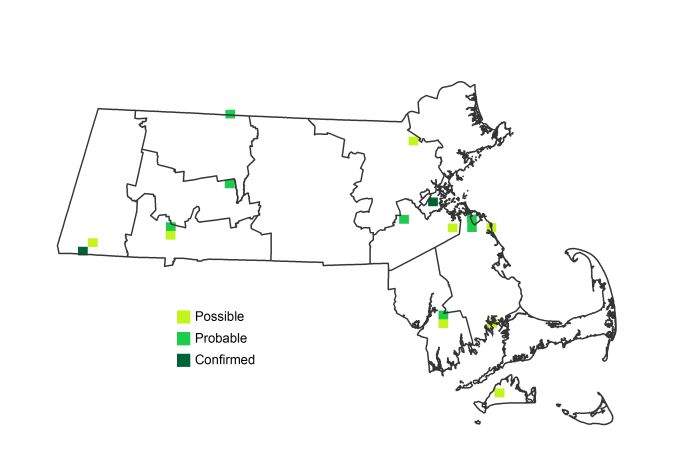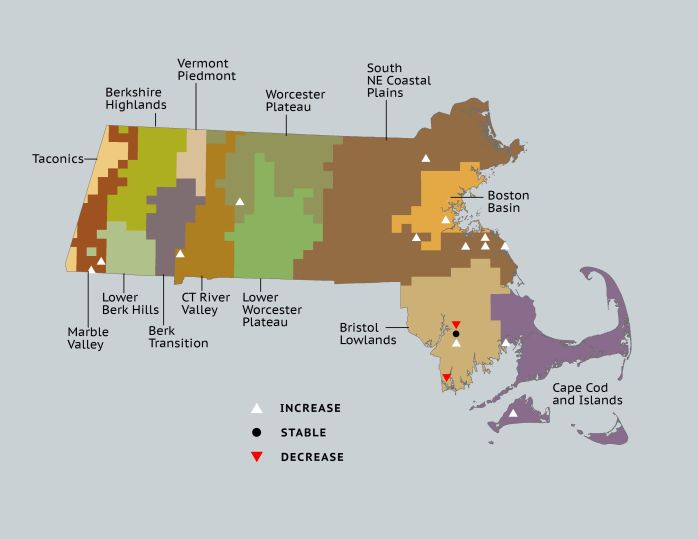Find a Bird
Hooded Warbler
Wilsonia citrina

Very local and strongly increasing
“Any observer who discovers one in a whole year may consider himself fortunate.” – Wallace Bailey, Birds in Massachusetts: When and where to find them
Hooded Warblers are quite rare breeders in Massachusetts. Their rarity, of course, only adds to their appeal in the eyes of the enthusiastic birders who search for them. These boldly patterned birds nest in the heavy undergrowth of mature forests, and only a few are known to attempt to breed in the state during any given year. Continued expansion of this southern species into New England seems likely, but it appears to be proceeding slowly.
Historic Status
Nineteenth-century ornithologist Henry Davis Minot was not ready to take a chance with his reputation, at least as far as the Hooded Warbler was concerned. “The Hooded Warbler, never, so far as I know,” he wrote, “strays to Massachusetts, or any part of New England, though vaguely reported to do so. I have, therefore, omitted it,” (Minot 1877). He was right to do so – for about a year. On June 25, 1879, William Adair collected one in Brookline, which marked the first in a long series of individual sightings that lasted well into the future (Howe & Allen 1901). The species was still a rarity in Massachusetts in the 1950s, but at least continued to be a long-shot possibility when birders took to the field each May in search of warblers.
Atlas 1 Distribution
Since it is a recently arrived breeding species from the south, one would expect that the Hooded Warbler’s distribution would be most concentrated in the southern parts of the state. Such a prediction was borne out during Atlas 1, which failed to Confirm the Hooded Warbler as a breeding species, despite the presence of multiple singing males in the Bristol/Narragansett Lowlands. No hint of breeding was found in any other ecoregion.
Atlas 2 Distribution and Change
Despite their questionable status during Atlas 1, Hooded Warblers were breeding during Atlas 2, and they were Confirmed in 2 blocks. Low-lying areas with extensive river systems, such as the Marble Valleys and Connecticut River Valley, were the best places to find this species as it moved into Massachusetts from the southern US. Two Probable records in the Worcester Plateau were interesting exceptions to the species’ trend of lowland distribution, and indeed all other breeding records came from farther east. In particular, the Confirmed breeding of Hooded Warblers in the Boston Basin speaks to the widespread availability of mature forest habitat even alongside some of the state’s densest settlements.
Atlas 1 Map

Atlas 2 Map

Atlas Change Map

Ecoregion Data
Atlas 1 | Atlas 2 | Change | ||||||
Ecoregion | # Blocks | % Blocks | % of Range | # Blocks | % Blocks | % of Range | Change in # Blocks | Change in % Blocks |
Taconic Mountains | 0 | 0.0 | 0.0 | 0 | 0.0 | 0.0 | 0 | 0.0 |
Marble Valleys/Housatonic Valley | 0 | 0.0 | 0.0 | 2 | 5.1 | 11.8 | 2 | 5.1 |
Berkshire Highlands | 0 | 0.0 | 0.0 | 0 | 0.0 | 0.0 | 0 | 0.0 |
Lower Berkshire Hills | 0 | 0.0 | 0.0 | 0 | 0.0 | 0.0 | 0 | 0.0 |
Vermont Piedmont | 0 | 0.0 | 0.0 | 0 | 0.0 | 0.0 | 0 | 0.0 |
Berkshire Transition | 0 | 0.0 | 0.0 | 1 | 2.5 | 5.9 | 0 | 0.0 |
Connecticut River Valley | 0 | 0.0 | 0.0 | 2 | 3.1 | 11.8 | 1 | 2.1 |
Worcester Plateau | 0 | 0.0 | 0.0 | 1 | 1.1 | 5.9 | 1 | 2.1 |
Lower Worcester Plateau | 0 | 0.0 | 0.0 | 0 | 0.0 | 0.0 | 0 | 0.0 |
S. New England Coastal Plains and Hills | 0 | 0.0 | 0.0 | 6 | 2.1 | 35.3 | 6 | 2.7 |
Boston Basin | 0 | 0.0 | 0.0 | 1 | 1.8 | 5.9 | 1 | 1.8 |
Bristol and Narragansett Lowlands | 3 | 2.8 | 100.0 | 2 | 1.8 | 11.8 | -1 | -1.0 |
Cape Cod and Islands | 0 | 0.0 | 0.0 | 2 | 1.4 | 11.8 | 2 | 1.7 |
Statewide Total | 3 | 0.3 | 100.0 | 17 | 1.6 | 100.0 | 12 | 1.4 |
Notes
The Hooded Warbler shows a significant increasing Breeding Bird Survey trend in the Eastern US overall.



